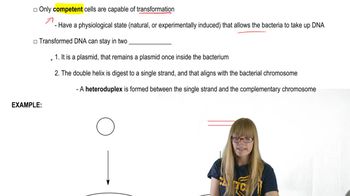Table of contents
- 1. Introduction to Genetics51m
- 2. Mendel's Laws of Inheritance3h 37m
- 3. Extensions to Mendelian Inheritance2h 41m
- 4. Genetic Mapping and Linkage2h 28m
- 5. Genetics of Bacteria and Viruses1h 21m
- 6. Chromosomal Variation1h 48m
- 7. DNA and Chromosome Structure56m
- 8. DNA Replication1h 10m
- 9. Mitosis and Meiosis1h 34m
- 10. Transcription1h 0m
- 11. Translation58m
- 12. Gene Regulation in Prokaryotes1h 19m
- 13. Gene Regulation in Eukaryotes44m
- 14. Genetic Control of Development44m
- 15. Genomes and Genomics1h 50m
- 16. Transposable Elements47m
- 17. Mutation, Repair, and Recombination1h 6m
- 18. Molecular Genetic Tools19m
- 19. Cancer Genetics29m
- 20. Quantitative Genetics1h 26m
- 21. Population Genetics50m
- 22. Evolutionary Genetics29m
5. Genetics of Bacteria and Viruses
Bacterial Transformation
Problem 21b
Textbook Question
Textbook QuestionPenicillin was first used in the 1940s to treat gonorrhea infections produced by the bacterium Neisseria gonorrhoeae. In 1984, according to the CDC, fewer than 1% of gonorrhea infections were caused by penicillin-resistant N. gonorrhoeae. By 1990, more than 10% of cases were penicillin-resistant, and a few years later the level of resistance was at greater than 95%. Almost every year the CDC issues new treatment guidelines for gonorrhea that identify the recommended antibiotic drugs and dosages.
What are the short-term implications of these frequent changes for physicians and clinics that treat sexually transmitted diseases like gonorrhea and for individuals infected with gonorrhea?
 Verified Solution
Verified SolutionThis video solution was recommended by our tutors as helpful for the problem above
Video duration:
3mPlay a video:
192
views
Was this helpful?
Related Videos
Related Practice

